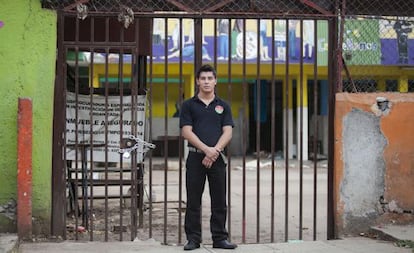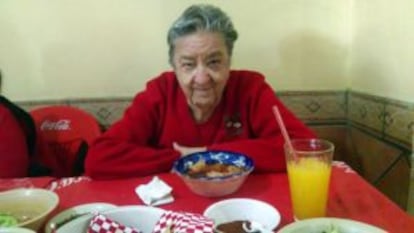Mamá Rosa’s kids tell their stories
Six months ago, Mexican authorities shut down the shelter for failing to meet standards

Rosa Verduzco, the woman at the center of the scandal that brought down a shelter known as La Gran Familia – a facility Mexican authorities demolished in July 2014 because it failed to meet official standards – is now living a discreet life in Zamora, Michoacán (southern Mexico).
She shies away from the media, responds to inquiries through third parties, and prefers to follow her attorney’s advice to stay out of the spotlight. Prosecutors dropped all charges against her because she suffers from senile dementia.
Meanwhile, her “children,” or at least those who were at the orphanage when the police raided the establishment, were sent to live at different government shelters in or near their supposed hometowns. Some are in Morelia, the capital of Michoacán. Others are living in Mexico State and some, like Luis Fernando Ceniceros, are still in Zamora.
Ceniceros is 19 years old. Once the shelter closed, he found a job at a company that belongs to one of Verduzco’s friends. He says he misses the home, especially “the music classes.” La Gran Familia's orchestra brought fame to the shelter. “I was one of its best musicians,” Ceniceros says with a shy smile. “Things went better for those of us who played well.” By “things went better,” he means they received better clothing, food and board.
Mamá Rosa’s home helped many people survive but it hung in legal limbo, even though Mexican authorities were aware of complaints
The young man lived in the front courtyard on Mamá Rosa’s 2,500-square-meter property. The facility provided licensed primary and secondary schooling. It also offered music classes. But not all students attended classes willingly. Twenty-year-old Luis Eduardo Oropeza Gómez told Mexican authorities that he was not allowed to leave the premises precisely because of his musical abilities.
Meanwhile, these talented players did not realize what life was like in “the backyard,” home to many kids whose parents were in prison. An official document says the shelter also housed at least seven babies who had been born within its walls. The front yard, visible from the street, shows a display of colorful mural paintings. A portrait of former First Lady Martha Sahagún, the spouse of ex-president Vicente Fox and a native of Zamora, adorned one of the walls of its music school.
The front yard also housed a basketball court, the nurse's office and bedrooms for the young musicians. These talented students were so isolated from the rest that Luis Fernando says he did not notice the police raid that took place on July 15.
Besides the buildings in the main courtyards, La Gran Familia had a small stable where hens, pigs, and cows were kept. There was an enormous garden and a food storage unit.

Mamá Rosa's supporters insist that her social work, which began in 1947, speaks for itself. There are plenty of stories about the 13-year-old girl from a well-to-do family who decided to take in a street kid. “The entire city joined in to help her,” Alberto Sahagún Bribiesca says with nostalgia.
Sahagún Bribiesca is a prestigious Zamoran doctor and Vicente Fox’s brother-in-law. He is also one of Mamá Rosa’s most loyal advocates. He says the police destroyed her work “in minutes.” “I was an eyewitness. I watched how they destroyed the cots and beds. They were looking for drugs. How do you think they were going to produce that pile of garbage?”
Asked about the storage unit, a particularly rundown spot filled with rotting food, he says: “Have you been inside a juvenile detention center? They are not a pretty sight, are they?” The boarders who lived at the shelter say, given the bars and management style, that La Gran Familia was not an orphanage but a prison. Yet Sahagún insists: it was the authorities who destroyed the facility. “The stories of Mamá Rosa’s kids who are now helping their brothers and sisters have not been told,” he says. “They are keeping her work alive.”
Verduzco took in her first child in 1947, and by 1973, when that figure had grown to several dozen, La Gran Familia became a civic association. Nobel Prize winners, writers, historians, politicians, athletes, and musicians visited the facility. Many orphans who lived there are now scientists and scholars.
When officials entered the shelter in July of last year, they found almost 600 people living inside in appalling conditions, including at least 425 minors. Most of these underage boarders now live in government shelters, even though at least 54 of them had come to La Gran Familia through national child protection services. The Office of the Under Secretary for the Prevention of Crime has placed several of the adult boarders in special programs.
In their official testimonies, Mamá Rosa’s kids tell hundreds of unhappy stories. María Esther Verduzco Verduzco, for example, was a newborn when she arrived at the shelter, and she had a child while living there. María Esther took Mamá Rosa’s last names because the owner adopted her. Her birth certificate provides no information about her family. She does not even know the date of her birth. There are dozens of people in María Esther’s situation. “Deceased parents.” “Does not remember.” “Does not want to see parents.” “Taken against own will.” “No one visits.” “Escaped but was found again.” “Been here for 10 years.” “Pregnant.”
Although Mamá Rosa’s home helped many people survive, it hung in legal limbo. And Mexican authorities were aware of the criticism. Ex-president Felipe Calderón supported Verduzco’s facility despite the fact that several formal complaints had been filed against her.
Now, La Gran Familia no longer exists. The shelter is closed, and two police officers are standing guard over the property. A few meters away, Luis Fernando lowers his eyes as he tells his story. He was born in Guadalajara. His parents abandoned him. His uncle and aunt took him to a shelter. Then he was sent to Mamá Rosa. He has not been in touch with them since. Would he like to see them? “Well yes, but I have to move forward.” His dream? “I want to keep studying. I was already finishing up high school. I want to work.”
Translation: Dyane Jean François
Tu suscripción se está usando en otro dispositivo
¿Quieres añadir otro usuario a tu suscripción?
Si continúas leyendo en este dispositivo, no se podrá leer en el otro.
FlechaTu suscripción se está usando en otro dispositivo y solo puedes acceder a EL PAÍS desde un dispositivo a la vez.
Si quieres compartir tu cuenta, cambia tu suscripción a la modalidad Premium, así podrás añadir otro usuario. Cada uno accederá con su propia cuenta de email, lo que os permitirá personalizar vuestra experiencia en EL PAÍS.
¿Tienes una suscripción de empresa? Accede aquí para contratar más cuentas.
En el caso de no saber quién está usando tu cuenta, te recomendamos cambiar tu contraseña aquí.
Si decides continuar compartiendo tu cuenta, este mensaje se mostrará en tu dispositivo y en el de la otra persona que está usando tu cuenta de forma indefinida, afectando a tu experiencia de lectura. Puedes consultar aquí los términos y condiciones de la suscripción digital.
Últimas noticias
The complicated life of Francesca Albanese: A rising figure in Italy but barred from every bank by Trump’s sanctions
Pinochet’s victims grapple with José Antonio Kast’s rise in Chile
Reinhard Genzel, Nobel laureate in physics: ‘One-minute videos will never give you the truth’
From digital curfews to blocking apps: How technology experts protect their children online
Most viewed
- Why we lost the habit of sleeping in two segments and how that changed our sense of time
- Trump’s obsession with putting his name on everything is unprecedented in the United States
- Charles Dubouloz, mountaineering star, retires at 36 with a farewell tour inspired by Walter Bonatti
- The Florida Keys tourist paradise is besieged by immigration agents: ‘We’ve never seen anything like this’
- Living in a motorhome due to soaring housing prices in Madrid: ‘I got used to it quickly, but I don’t idealize it’








































